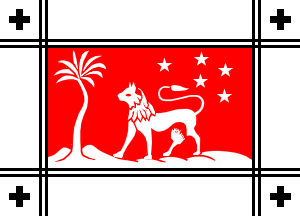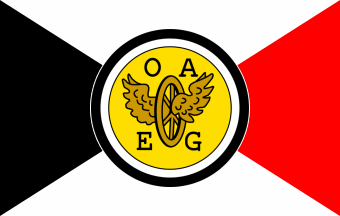 Image by Fornax, 25/4/11
Image by Fornax, 25/4/11
![[German East Africa proposal 1914 (Germany)]](../images/d/de!gea13.gif) Image by Mark Sensen, 13/2/98
Image by Mark Sensen, 13/2/98
Last modified: 2022-10-22 by bruce berry
Keywords: german east africa | tanga |
Links: FOTW homepage |
search |
disclaimer and copyright |
write us |
mirrors
Following the 1885 Congress of Berlin, which delimited European spheres of influence in Africa and so set the ground rules for the Scramble for Africa, the territory which became Tanganyika fell within the German sphere. By 1890 German East Africa comprised the modern-day territories of Tanganyika, Burundi and Rwanda.
Stuart Notholt, 29 Jun 1996
There are coloured prints of the jack and ensign of "German government vessels engaged in East African trade", in the 1892 amendments to the Admiralty Flag Book. The jack is the merchant flag with a plain blue anchor in the centre of the white band, and the ensign a Reichskriegsflagge with a plain blue
anchor in the lower hoist. [National Archives (PRO) ADM 116/353]
"The German civil ensign - a horizontal tricolor black white red - flew over Witu and was carried by askaris."
A photograph shows the German flag being dipped to the Sultan of Witu when he reviewed askaris in front of his palace c1882.
[Article "The Forgotten Flags of Witu" by James Marill in (probably) an issue of the Flag Bulletin]
David Prothero, 28 Oct 2003
 Image by Fornax, 25/4/11
Image by Fornax, 25/4/11
![[German East Africa proposal 1914 (Germany)]](../images/d/de!gea13.gif) Image by Mark Sensen, 13/2/98
Image by Mark Sensen, 13/2/98
In Schurdel 1995 there is a short chapter, illustrated with some flags used in the former German colonies. It is said that in the year 1914 there was a decision to grant the colonies some flags. This idea was based on the fact that the British possessions flew the blue ensign with the badge of the colonies. Germany had to show its flags also. The flags proposed —but never seen since in 1919 Germany lost all its colonies— were all black-white-red horizontally defaced with the coat-of-arms of the colony in the center. Only six coats-of-arms are known. They have all a chief (top of the shield) with the black Prussian eagle on white:
In contrast to territories which made up the British Empire, virtually all of which were granted a distinctive heraldic and vexillological identity, German colonies and protectorates did not have their own heraldic devices or flags. Following in the Portuguese and Dutch colonial practice, the Germans treated their overseas possessions an an integral part of one empire and consequently the Imperial German arms and flags were used throughout the Empire.
During a visit by the then German Secretary of State, Dr. Solf, to German possessions in Africa during 1912-1913, he noted that each of the British colonial territorities had their own distinctive colonial emblem. The fact that these 'colonial flags' all followed a single pattern made a great impression on Dr. Solf who submitted a memorandum to Kaiser Wilhelm II stressing the desirability of adopting distinctive emblems for Germany's overseas possessions. He went to far as to suggest that the matter receive urgent attention. The Kaiser agreed and suggested that Dr. Solf take the necessary steps to prepare the appropriate designs. In close co-operation with Johann Albrecht, Duke of Mecklenburg and the Herald's Office a series of designs were prepared and submitted to the Kaiser.
The flags were to be based on the German horizontal tricolour of black,
white and red charged in the centre with a distinctive shield of the colony.
The outbreak of World War I in 1914 diverted attention to more pressing
matters and the flags designed for Germany's colonial possessions were never taken into use.
Bruce Berry, 13 Feb 1998
![[Flag of the Colonial Governors 1898-1919 (Germany)]](../images/d/de^gv898.gif) 2:3 image by Dave Martucci and António Martins
2:3 image by Dave Martucci and António Martins
Flag adopted 4 May 1891, abolished 1919
The national flag with the uncrowned imperial eagle in the center of the white stripe. Adopted 1st March 1898. Abolished during the First World War as a result of allied conquest of the colonies. (Illustrated in Crampton 1990 p. 42, Meyers Konversations-Lexikon 1912 vol. 4, facing p. 799, National
Geographic 1917 p. 367, no. 1014).
Norman Martin
This flag also flew over German Southwest Africa, Kamerun, Togoland, and Germany's Pacific possessions. It was used in German East Africa; I do not know about the others.
Stuart Notholt, 15 February 1996
Flags of Maritime Nations 1899 shows this flag as the flag of the Governor of German East Africa and does not mention Kiao-Chau (Tsingtao). (...) Kiao-Chau was made a German protectorate in 1898, so maybe the information was not yet available when the 1899 book was published. National Geographic 1917 shows it for both territories and notes that they were both conquered by that date by the allies (Britain in Africa, Japan in China).
Dave Martucci, 21 September 1996
The eagle on the Colonial Governors' flag shows several differences with that on the Foreign Office flag:
Are these mistakes or was it a different eagle indeed? Maybe this was the 1867-1892 (?) eagle?
Santiago Dotor, 23 May 2000
The escutcheon is intended to be the Prussian arms.
Norman Martin, 23 May 2000
 Image by Eugene Ipavec, 24 April 2011
Image by Eugene Ipavec, 24 April 2011
The German East Africa Company was an organization established at the start of the German colonization of East Africa. This company, in short, was responsible for the governing and development of the region for the Second Reich. It had, naturally both positive and negative effects in the region, and was unpopular with the native population.
It is a less known fact that the East Africa Company used this flag from about 1885 until the company adopted its more popular and well-known flag of 1895.
Text modified from Historical Flags of Our Ancestors website, 24 April 2011
![[German East Africa Company (Germany)]](../images/d/de-doag.gif) 3:5 image by Mark Sensen, 13 Feb 1998
3:5 image by Mark Sensen, 13 Feb 1998
I believe the German East African Company had a white flag with a black cross on it. The canton was red with a constellation of five white stars resembling the southern cross set at an angle.
Stuart Notholt, 15 February 1996
In 1891, native rebellions made it apparent that the Company could not handle its dominions, and it lost its monopoly to the German government which began to rule German East Africa directly, thus relegating the Company to running some plantations and trade business.
The German East Africa Company began using this new flag about 1895. After World War I this flag was the symbol that unified all neo-colonial institutions and organizations. It was the most popular among all German Colonial flags.
Text modified from Historical Flags of Our Ancestors website, 24 April 2011
 Image by Eugene Ipavec, 24 April 2011
Image by Eugene Ipavec, 24 April 2011
The German East African Railway Company (Deutsch-Ostafrikanischen Eisenbahn-Gesellschaft) was was founded in 1904 and attempted construction of the Usambara Railway that would connect the Port of Tanga (Mombasa) to Lake Victoria by passing south of the Usambara Mountains, but after taking two years to build 40 kms of line, the Usambara Railway (Usumbara Bahn) was declared bankrupt and construction had to be taken over by the German Government. The line eventually reached Moshi in 1912. The Usambara Railway was the first railway to be built in German East Africa in what is today Tanzania.
The flag of the East African Railway Company was a black and white red diagonally divided flag, on which a circular winged track, as well as the initials of the company, centered on the flag.
Text modified from Historical Flags of Our Ancestors website, 24 April 2011
Flag Reconstruction by Jaume Ollé First draft submitted |
Modified Coat of Arms by Fornax |
Flag Reconstruction by Fornax Final approved Flag Design |
This is the flag and shield of Tanga, German East Africa (1914).
Jaume Ollé, 02 Jul 1997
With the outbreak of war in 1914, the British moved to occupy the territory. Unfortunately for the tens of thousands of British, Indian, South African and other Empire troops eventually bogged down in East Africa, the German forces commander, Colonel Paul von Lettow-Vorbeck, was a brilliant guerrilla leader. By the end of the European war in 1918, von Lettow and his troops (most of whom were black, by the way) were still in the field, having led no less a figure than the South African General Jan Christiaan Smuts a merry dance through the bush, including excursions into Kenya and the Portuguese territory of Mozambique (Portugal being an ally of Britain during World War I).
Stuart Notholt, 29 Jun 1996
By the middle of 1914, the first draft for the Tanga coat-of-arms and flag was being examined by the Heroldsamt (Supreme Heraldic Office) in Berlin. The Heroldsamt recommended a few design changes which resulted in a second and final draft. However, the documents of the Supreme Colonial Office indicate that neither version of the arms nor any flag were ever officially approved and that the whole case was dropped after East Africa had been lost to the Allies.
Text from Historical Flags of Our Ancestors, 25 April 2011